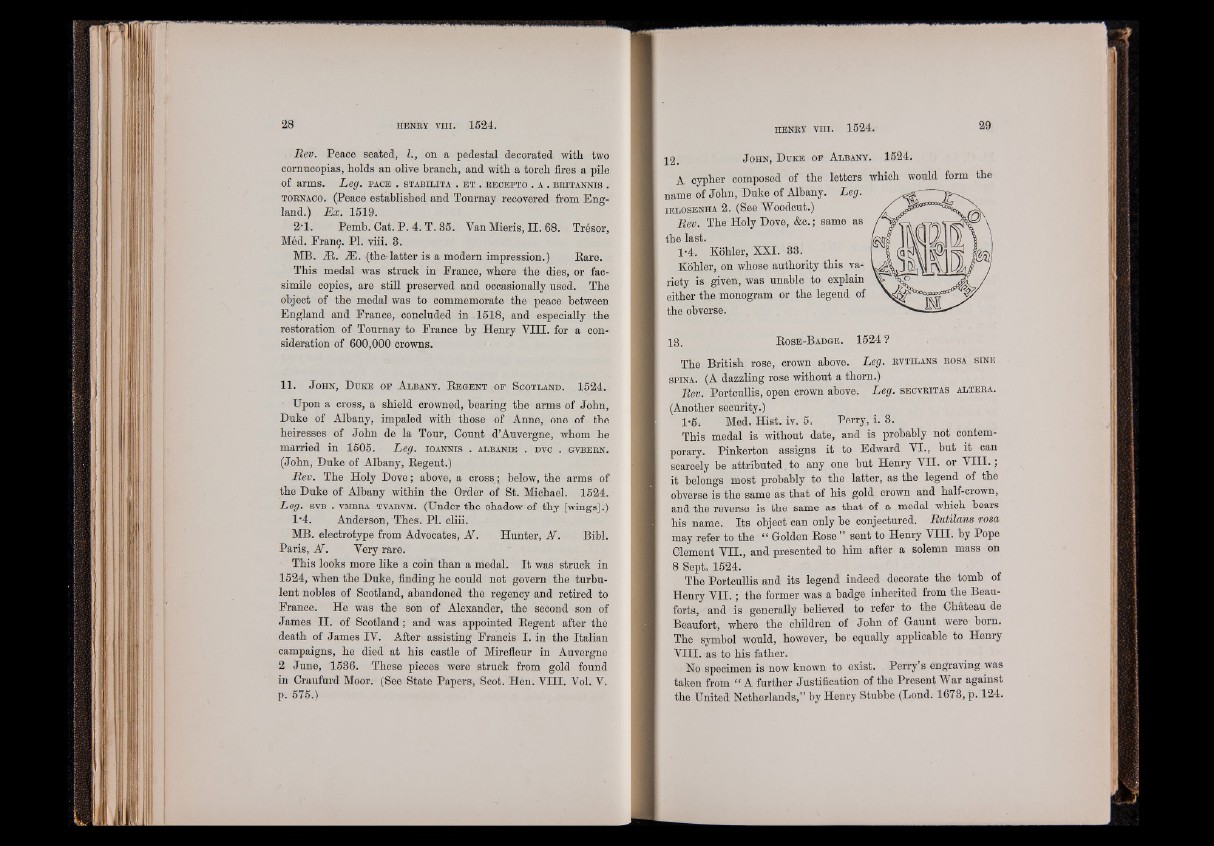
Rev. Peace seated, I., on a pedestal decorated with two
cornucopias, holds an olive branch, and with a torch fires a pile
of arms. Leg. p a c e . s t a b l l i t a . e t . r e c e p t o . a . b r i t a n n i s .
t o r n a c o . (Peace established and Tournay recovered from England.)
Ex. 1519.
2'1. Pemb. Cat. P. 4. T. 35. Van Mieris, II. 68. Trésor,
Méd. Franç. Pl. viii. 3.
MB. Æ. Æ. (the-latter is a modern impression.) Bare.
This medal was struck in France, where the dies, or facsimile
copies, are still preserved and occasionally used. The
object of the medal was to commemorate the peace between
England and France, concluded in 1518, and especially the
restoration of Tournay to France by Henry YIII. for a consideration
of 600,000 crowns.
11. J ohn, D uke of Albany. R e g e n t ,of Scotland. 1524.
1 Upon a cross, a shield crowned, bearing the arms of John,
Duke of Albany, impaled with those of Anne, one of the
heiresses of John de la Tour, Count d’Auvergne, whom he
married in 1505. Leg. i o a n n i s . A lb a n i e . d v c . g v b e r n .
(John, Duke of Albany, Regent.)
Rev. The Holy Dove; above, a cross; below, the arms of
the Duke of Albany within the Order of St. Michael. 1524.
Leg. s v b . vm b r a t v a r v m . (Under the shadow of thy [wings].)
1'4. Anderson, Thes. PI. cliii.
MB. electrotype from Advocates, N . Hunter, N . Bibl.
Paris, N . Yery rare.
This looks more like a coin than a medal. I t was struck in
1524, when the Duke, finding he could not govern the turbulent
nobles of Scotland, abandoned the regency and retired to
France. He was the son of Alexander, the second son of
James II. of Scotland; and was appointed Regent after the
death of James IY. After assisting Francis I. in the Italian
campaigns, he died at his castle of Mirefleur in Auvergne
2 June, 1536. These pieces were struck from gold found
in Craufurd Moor. (See State Papers, Scot. Hen. YIII. Vol. Y.
p. 575.)
12. Jo h n , D u k e o f A lb a n y . 1524.
A cypher composed of the letters which would form the
name of John, Duke of Albany. Leg.
i e l o s e n h a 2. (See Woodcut.)
Rev. The Holy Dove, &c. ; same as
the last.
1-4. Köhler, XXI. 33.
Köhler, on whose authority this variety
is given, was unable to explain
either the monogram or the legend of
the obverse.
13. R ose-Badge. 1524 ?
The British rose, crown above. Leg. r v t i l a n s r o s à s i n e
sp in a . (A dazzling rose without a thorn.)
Rev. Portcullis, open crown above. Leg. s e c v r i t a s a l t e r a .
(Another security.)
1-5. Med. Hist. iv. 5. Perry, i. 3.
This medal is without date, and is probably not contemporary.
Pinkerton assigns it to Edward VI., but it can
scarcely be attributed. to any one but Henry VII. or YIII. ;
it belongs most probably to the latter, as the legend of the
obverse is the same as that of his gold crown and half-crown,
and the reverse is the same as that of a medal which bears
his name. Its object can only be conjectured. Rutilans rosa
may refer to the “ Golden Rose ” sent to Henry VHI. by Pope
Clement VII., and presented to him after a solemn mass on
8 Sept. 1524.
The Portcullis and its legend indeed decorate the tomb of
Henry VII. ; the former was a badge inherited from the Beauforts,
and is generally believed to refer to the Château de
Beaufort, where the children of John of Gaunt were born.
The symbol would, however, be equally applicable to Henry
VIII. as to his father.
No specimen is now known- to exist. Perry s engraving was
taken from “ A further Justification of the Present War against
the United Netherlands,” by Henry Stubbe (Lond. 1673, p. 124.